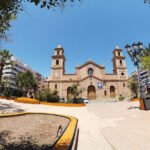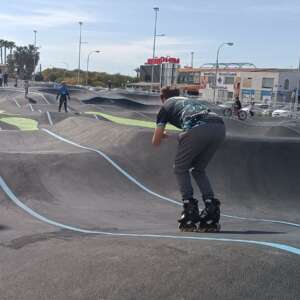
Tuesday sees the start of the second and most important phase of the special operation monitoring traffic flow for the Easter holiday period.

The operation begins in all autonomous communities, with the exception of Cantabria, Catalonia and the Valencian Community, where it begins on Thursday.
This phase is considered the most important of the year because of the volume and vehicle displacement along the entire road network and in a very limited period of time.
Of the 15.5 million trips planned for the entire Semana Santa Special Operation (from March 23 to April 2), 9.07 million will occur during this second phase, so it is advisable to plan your journey and avoid most unfavourable times.
The Director General of Traffic, Gregorio Serrano, has called for prudence and respect for traffic regulations. “We have prepared all the material and human resources available to ensure the safety and fluidity of travel, but we need the commitment, not only of most drivers who have correct behaviour on the road, but of those others who are reluctant to comply with the rules and endanger the lives of others. Towards them we direct all means of control that we have to get them off the road.”
During this second operation, the main flow of traffic will be made from the urban centres to coastal tourist areas, second residences, towns with traditional religious acts or mountainous areas of touristic interest.
ROAD FORECASTS
Wednesday, March 28
In the communities of Andalucía, Aragón, Asturias, Baleares, Canarias, Castilla la Mancha, Castilla y León, Extremadura, Galicia, Madrid, Murcia, Navarra, País Vasco and La Rioja, problems of traffic and queues from the exits of the large urban centres, between 13:00 and 24:00 are expected to be busy, with the timeframe between 15:00 and 23:00 being the worst.
- ANDALUCIA: Carreteras: AP-4, AP-7, A-4, A-7, A-45, A-49 y A-92
- GALICIA: Carreteras: AP-9, A-6, A-52, A-55, N-550 y N-634
- ARAGÓN: Carreteras: AP-2, AP-68, A-2 y A-23
- MADRID: Carreteras: AP-6, A-1, A-2, A-3, A-4, A-5, A-6 y M-40
- ASTURIAS: Carreteras: A-8, A-66, N-634.
- MURCIA: Carreteras: A-7, A-30 y N-301-A
- BALEARES: Carreteras: Ma-19 y Ma-20
- NAVARRA: Carreteras: AP-15, A-1, A-10, A-12, A-15 Y A-21
- CASTILLA – LA MANCHA: Carreteras: AP-36, A-3, A-4, A-5, A-30, A-31, A-40, A-41 y A-42
- PAIS VASCO: Carreteras: AP-8, AP-68, A1 y A-8
- CASTILLA y LEÓN: Carreteras: AP-1, AP-6, A-1, A-6, A-52, A-62, A-66, N-620 y N-630
- LA RIOJA: Carreteras: AP-68, N-111 y N-232
- EXTREMADURA: Carreteras: A-5 y A-66
Thursday, March 29
During the morning of Thursday the exits of large towns and cities will continue to produce queues, with the most unfavourable times being between 07:00 and 15:00, the worst being from 08:00 to 14:00.
In the afternoon, one day after the rest of the communities, Catalonia, Cantabria and Comunidad Valenciana, as it is not a public holiday in these regions, will begin their second phase of the operation. The main traffic problems will occur on the access roads to the coast, which connect coastal populations, as well as access to tourist rest areas. The times to try to avoid here will be between 12:00 and 23:00, with the worst times being from 13:00 to 22:00.
- CANTABRIA: Carreteras: A-8, A-67, S-10 y S-30.
- COMUNIDAD VALENCIANA: Carreteras: AP-7, A-3, A-7 y CV-35.
- CATALUÑA: Carreteras: AP-2, AP-7, N-145, N-340, C-16, C-28, C-31, C-32 y C-35.
To mitigate possible traffic delays, during the afternoon-night of Wednesday and all of Thursday, extra measures of regulating traffic and traffic flow will be installed on the roads of greater intensity to favour the departure of vehicles from large cities.
Friday, March 30
During the morning of Friday, in Cantabria, Catalonia and Valencia, the flow of traffic will continue in the direction away from the big cities towards the coast.
In the rest of the communities, displacements will occur at the exit of large urban centres on short-haul routes, to leisure and recreation areas close to urban centres.
The busiest times will be between 09:00 and 14:00, but worse from 10:00 to 13:00.
In the afternoon and throughout the national territory, there will be movements of short-haul vehicles in areas where religious processions are held
Saturday, March 31
In the morning there may be traffic problems in the coastal and mountainous areas where the movements will be mostly local.
In the afternoon, the traffic flow will start to focus on anticipating the return to inland areas, especially those people looking to void the busiest times later in the weekend.
Sunday, April 1
From midmorning, an increase in traffic flow is expected, and some queues may be produced in the exits from the tourist locations back inland. Later on, as these vehicles start to arrive at their destinations, the queues will start at the entrances of the large cities. .
The Autonomous Communities affected by the return are Andalucía, Aragón, Asturias, Canarias, Cantabria, Castilla-La Mancha, Castilla y León, Extremadura, Galicia, Madrid, Murcia and La Rioja.
The times which will be busiest will be between 11:00 and 24:00, with the worst times being from 12:00 to 23:00.
Monday, April 2
The return operation in Baleares, Cataluña, Comunidad Valenciana, Navarra and País Vasco begins, where Monday is a holiday.
Problems will central around the main road axes of these communities, as well as in the access roads of the provinces bordering on them.
In the rest of the Autonomous Communities there will also be return movements, mainly motivated by plans for the next day, the return to school and university activities.
The busiest times will be between 11:00 and 24:00, with the worst times being from 12:00 until 23:00.
The Plan
To provide coverage for the planned trips, the DGT has devised a special device whose objective is to facilitate the mobility and fluidity of traffic, as well as ensuring road safety on the roads.
For this purpose, more than 800 officials and specialist technical personnel will be on duty in the Traffic Management Centres, all available agents of the Guardia Civil Trafico will be on duty, and more than 13,000 employees of conservation companies, road concessioners and other staff from the roads services networks will be on duty, assisted, if needed, by teams from the other emergency services both health and fire and rescue.
At the time of the greatest number of trips, reversible and additional lanes will be installed with cones on certain roads, works affecting roadways will be suspended, sports events and other events involving the occupation of roads will be limited and restricted. The transportation of dangerous goods and vehicles that require special authorisation will be restricted.
Attention to short trips and integral patrols
During this holiday period there are numerous short trips that are usually made on conventional roads and that is where the greatest number of fatal accidents usually occur. In these trips, the same precautions should be taken as on long journeys.
Curves, crossings, overtaking and changes of gradient, usually predominate in this type of road where it is very important to monitor and moderate speed accordingly. Remember, the 100 or 90 kilometres per hour on conventional roads is a limit, not a target, and may not be a suitable speed depending on traffic, road characteristics and conditions, and the weather.
Following their approval this week, some of the patrols will be carrying the new Velolaser portable speed monitoring equipment, which can be transported on motorbikes, and can be used both day or night with minimum setup.
Pegasus equipped helicopters will also be monitoring the roads from the sky, along with all other means at the disposal of the DGT to make the roads safer, which can be made so much more so by drivers and driving attitude.
Basic rule: Prevention and Prudence
Despite being advice already known to drivers, it is necessary to remember that safe driving begins at the same time as planning the trip. In addition, the DGT recommends:
- Car tuning. Check your vehicle before a long trip.
- Learn about the state of the roads through the means offered by Traffic: telephone 011, Internet, twitter @informacionDGT, the DGT App or in newsletters of radio and television stations.
- Follow, if desired, alternative itineraries designed by the DGT in order to avoid travelling through the centre of the Peninsula, which is the area with the highest traffic flow. These itineraries include estimated travel times based on the departure time of the trip.
- On roads with more than one lane in each direction, you must drive in the right lane, the left lane should only be used to overtake.
- Maintain the safety distance and adapt the speed to the circumstances, including the road and weather conditions.
- Pay attention to other road users: motorcycles, cyclists and pedestrians are more vulnerable, these road users must also pay attention.
- Use your lights to increase visibility.
- Always wear your seatbelt, or crash helmet and remember that despite alcohol limits being in place, the best limit is always zero, and always avoid using recreational drugs before driving.













